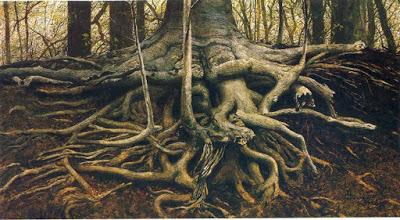Roots by Jamie Wyeth
In part 1 of my series on chakras Chakras: Guides on the Path to Healing I offered an overview of the chakras. This post will cover Muladhara, the root chakra. First, let me give you some context. If you are interested in original sources and how different systems use the chakras, check out Christopher Wallis, Ph.D., at The Real Truth About the Chakras for a deep dive into this complex and complicated topic. The traditional history is connected to the contemporary view by understanding that the chakras are, as Wallis informs us, prescriptive not descriptive: “The texts are prescriptive — they tell what you ought to do to achieve a specific goal by mystical means. When the literal Sanskrit reads, in its elliptical fashion, ‘four-petaled red lotus at the base of the body’ we are supposed to understand ‘The yogī ought to visualize a four-petaled lotus . . .” The specific goal can be optimal physical health, energetic balance, mental/emotional stability, or spiritual transformation. This context provides a blueprint for working with the energy of each chakra.Muladhara Chakra The word Muladhara is loosely translated as “base of support.” It’s location in the body is described in various ways:- Between the perineum and the pelvic bone
- Between the genitals and the anus
- Coccygeal plexus beneath the sacrum
- Base of the coccyx (tailbone)
- Chronic lower back pain
- Anxiety
- Sciatica
- Lethargy
- Hemorrhoids
- Constipation
In Mudras for Healing and Transformation, LePage, states that Adhi mudra should be practiced with caution if you have low blood pressure. I have low blood pressure but am able to practice Adhi mudra regularly with no problems. 3. Mental Practice: Roots Visualization I learned this Roots Visualization years ago from a yoga buddy. I use it to stand my ground in stressful situations instead of giving in to my first impulse to flee or freeze. I also practice it when I’m alone and feeling spacey and ungrounded. Instructions: 1. If possible, take off your shoes, connect your bare feet to the ground, and close your eyes. If you find yourself in a place or time where you cannot take off your shoes or close your eyes, direct your attention to your legs and feet to sense a deeper to the earth underneath you. 2. Begin to visualize roots growing from your body, starting from the base of the spine. Feel roots reaching down through your legs through the bottoms of your feet to pierce through the earth’s crust.3. Visualize your roots branching and spreading, growing stronger, and reaching deeper into the earth. Sense the strength, support, and the stability that your branching roots send back to fill your entire body. 4. With each inhalation, begin to draw in strength, support, and stability and allow that feeling to deepen your connection to the physical world and your place in it. 5. Draw these qualities through the bones of your feet and legs to the base of your spine and all the way up to the crown of your head. Feel your entire body safe, secure, stable, and connected to the physical world, allowing you to stand your ground and speak your truth.As you do this you may feel some tingling or pulsing in your feet and legs. That’s a good thing because energy flows where intention goes. You can shorten or lengthen the visualization as needed. When you attune yourself physically, energetically, and mentally to your need in the moment, you can stand your ground assertively, appropriately, and confidently. Subscribe to Yoga for Healthy Aging by Email ° Follow Yoga for Healthy Aging on Facebook and Twitter ° To order Yoga for Healthy Aging: A Guide to Lifelong Well-Being, go to Amazon, Shambhala, Indie Bound or your local bookstore.For information on Beth Gibbs' classes and upcoming workshops, see Beth's Classes and Workshops and for information about Beth, ProYoga Therapeutics, and Beth's book and CD, see proyogatherapeutics.com.


